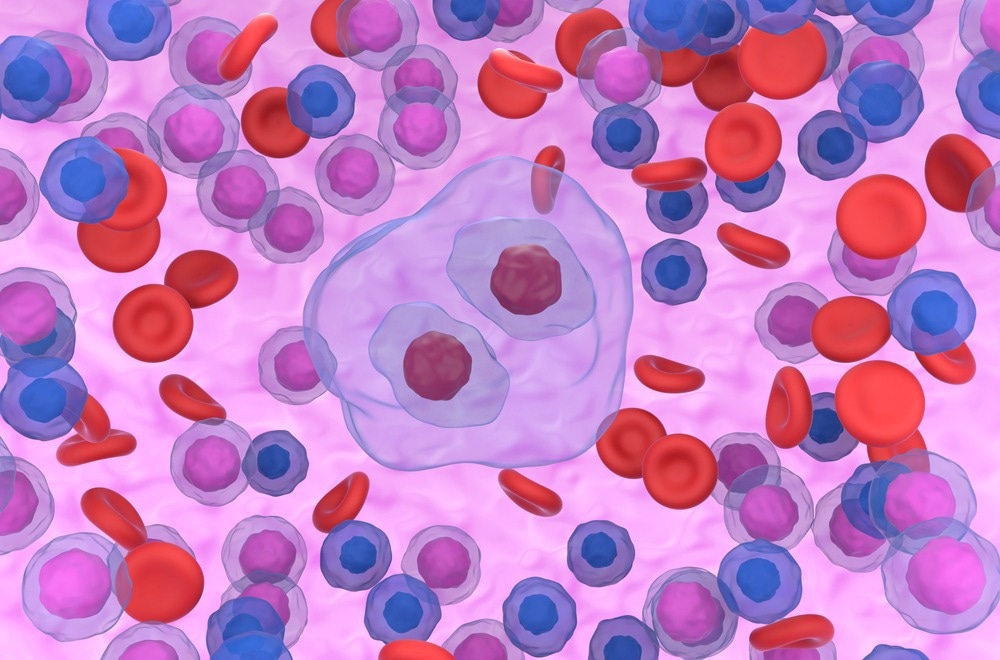The most detailed study of Hodgkin lymphoma, a type of blood cancer, has offered considerable insight into what tumor cells must do to sustain. The Wellcome Sanger Institute discovered that cancer cells utilize signals to attract specific types of immune cells and direct them not to attack.

Image Credit: Nemes Laszlo/Shutterstock.com
The study, which was published in Blood, also discovered that high concentrations of these cell clusters in existing sample data predicted chemotherapy failure. This understanding could be used to speed up the transition to precision medicine and identify patients who just might profit from newer immune-based therapies, which are more efficient when conventional therapies fail.
Hodgkin lymphoma is a cancer of the lymphatic system, a vital component of the human immune system that aids in the fight against infections and the destruction of abnormal cells. Hodgkin lymphoma is distinguished by the presence of Hodgkin/Reed-Sternberg cells, which are cancerous white blood cells known as B lymphocytes. B lymphocytes normally produce antibodies to aid in the fight against infections.
Hodgkin lymphoma affects approximately 2,100 people in the UK each year. Though most patients respond well to chemotherapy, radiotherapy, or a combination of the two, these treatments do not work for everyone. The good news is that these patients frequently respond favorably to new treatments such as “immune checkpoint inhibitors,” particularly PD-1 blockers.
In this recent study, investigators used a variety of methods to examine the immune microenvironment surrounding Hodgkin lymphoma tumors in extraordinary depth.
The Wellcome Sanger Institute produced single-cell sequencing and spatial transcriptomic data from Hodgkin lymphoma and healthy lymph node tissue to pinpoint the genes expressed by each cell and their position in relation to their neighbors. This was coupled with microscope imaging data from Newcastle University Hodgkin lymphoma biopsies.
Single-cell analysis showed that cancer cells were enveloped by immune cell clusters of macrophages, monocytes, and cDC2 dendritic cells. Data from imaging revealed that these cells expressed molecules that inhibited their anti-tumor abilities.
This study is a great example of how much information we can get out of one tissue sample. By combining single-cell, spatial transcriptome and histological data, we were able to learn how precisely Hodgkin lymphoma manages to evade immune response. You could think of this approach as a sort of roadmap for molecular pathology, which could be applied to other diseases as well.”
Dr Ben Stewart, Study First Author, Wellcome Sanger Institute
Researchers also discovered two distinct “microenvironments” around cancer cells, which indicated how effective conventional therapies would be. High concentrations of immune cell clusters around cancer cells predicted treatment failure, even though a high concentration of stromal cells in the microenvironment predicted treatment success.
Since stromal cells imply that tissue has been repaired earlier, it is possible that the immune system was already partially successful in combating the disease, with treatment offering a helping hand to completely eradicate cancer.
Understanding how Hodgkin lymphoma tumors bypass the body’s immune response opens up new possibilities to treat this disease. If we could identify which patients have higher concentrations of these immune cell clusters around the tumor, for example, we could tailor their treatments, limiting the effects of chemotherapy for patients in whom it is less likely to work and proceeding directly to immune-based therapies that stand a better chance.”
Dr Chris Carey, Study Senior Author, Newcastle University
A possible drug target is the cellular messaging used by cancer cells to manipulate immune cells. In theory, interrupting this signaling would enable the immune system to respond normally and attack the cancer cells.
Single-cell and spatial transcriptomic approaches are bringing a whole new level of detail for the study of human health and disease. When they are combined with other types of data, you can be incredibly specific about what is happening in the human body. This precision is key and I’m sure in time the data that we have generated in this study will have a positive impact on the treatment of Hodgkin lymphoma.”
Dr Sam Behjati, Study Senior Author, Wellcome Sanger Institute
Dr Sam Behjati is also associated with the Cambridge University Hospitals NHS Foundation Trust.
Source:
Journal reference:
Stewart, B. J., et al. (2023) Spatial and molecular profiling of the mononuclear phagocyte network in Classic Hodgkin lymphoma. Blood. doi.org/10.1182/blood.2022015575.